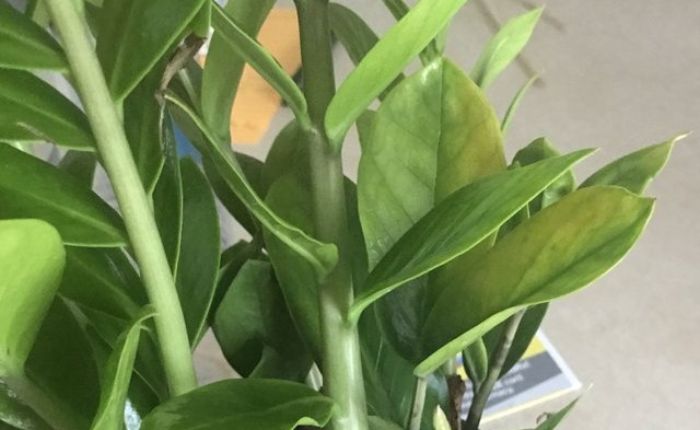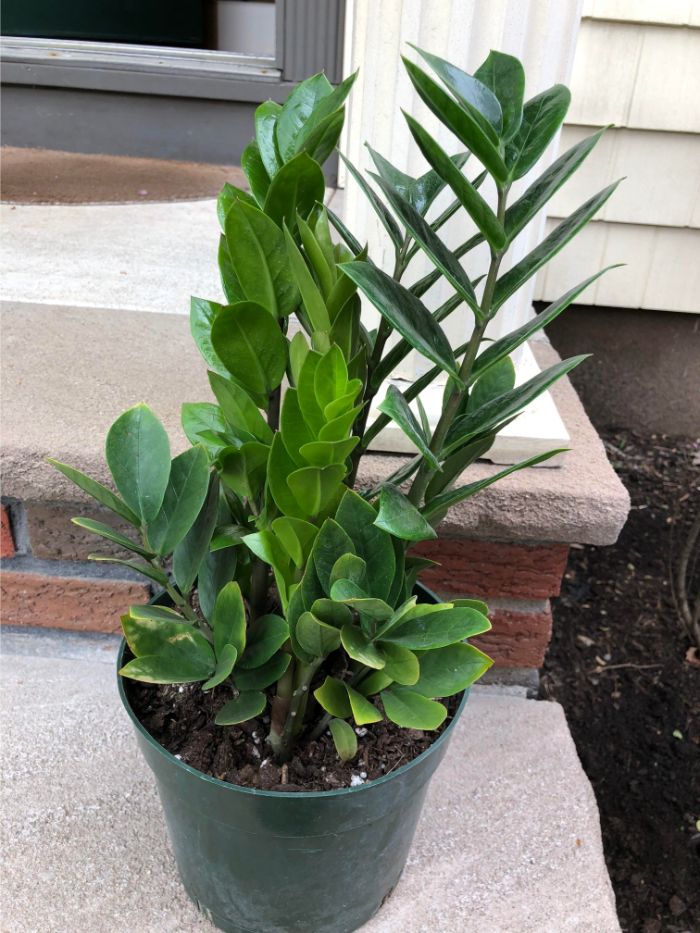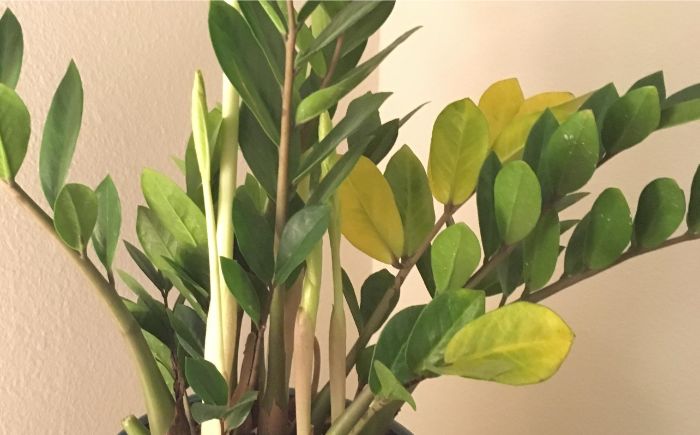If you are searching for a good-looking house plant that is easy to care for, the ZZ plant or Zamioculcas zamiifolia as it is also known, is a worthy contender. The most common problem that you might encounter is yellow leaves on your ZZ plant. This article will tell you how to fix this problem and prevent it in the future.
Why does my ZZ plant have yellow leaves? The most common reason for yellowing leaves in ZZ plants is overwatering which leads to root rot. However, yellowing leaves can also be a sign of underwatering, and more rarely can be due to extremes of temperature, light or fertilizing issues.
If your ZZ plant has yellow leaves, the cause could be one of a number of potential reasons. It is best to investigate the reasons to ensure that you understand what is making your house plant unhappy and know what course of action to take. Below we cover a variety of reasons why your ZZ plant might be presenting yellow leaves and include a few tips to ensure that once the plant is revived, yellow leaves don’t come back.
Top Reasons ZZ Plants Get Yellow Leaves
ZZ plants are fairly hardy house plants, which makes them a popular choice for people who don’t have a lot of time to dedicate to plant care. ZZ plants are considered drought resistant, which is just one of the reasons why they are so hardy.
Many people mistakenly think that this means the ZZ plant can withstand high heat and a lot of sun. The reality is that the ZZ plant is able to withstand very dry conditions, but they are less tolerant of high temperatures.
As a ZZ plant can cope with a decent amount of neglect, it often comes as quite a surprise when the leaves start yellowing. This is a cry for help…a sign that it needs a bit of attention, but what is the cause and what can you do?
When yellow leaves present themselves, it is most likely linked to your watering schedule. Adjusting when and how much you water your ZZ plant can go a long way towards reversing the damage and reviving the plant.
Below are possible reasons why your ZZ plant leaves might be yellowing and what you can do about it.

Overwatering A ZZ Plant Can Lead To Yellowing Leaves
As ZZ plants are designed to thrive in dry conditions, they can have an adverse reaction to excess watering. This is mainly due to fungal growth and root rot that occurs when the plant’s root system is exposed to a wet environment for an extended period of time.
Whether you are watering your plant too often or the soil isn’t draining well, wet roots lead to root rot, which then stops the steady supply of water and nutrients to leaves and the rest of the plant.
When root rot sets in, the root system simply cannot function like it should. This leads to leaves yellowing due to lack of water and nutrition reaching essential areas of the plant. Sometimes yellowing leaves will even fall off.
What to do if root rot from overwatering is the cause of yellow leaves:
- The first thing you need to do is a soil check. Does the soil feel very wet? If it does, you need to remove the plant from the pot so that you can take a closer look at the actual roots. The roots should be completely white all the way through. If they aren’t and you see brown areas of rot, then you have a root rot problem. Root rot disables the root from working, but if caught in time, it can be reversed.
- Use pruners to neatly cut the rot out of the roots. Remove the worst affected roots and cut incisions in healthy roots to encourage new growth of roots. Make sure to wash the pruners after cutting the rot away. This is because fungal growth contributes to root rot and can be spread if it contaminates your pruners and other equipment.
- Replant the ZZ plant into a pot with sufficient drainage holes. Discard the contaminated soil and use fresh soil. You should use a well draining growing medium to prevent a recurrence of the problem. Water the soil, but only to make it slightly damp. You must allow the soil to completely dry out before watering it again.
Underwatering A ZZ Plant Can Lead To Yellowing Leaves
A ZZ plant doesn’t need a lot of water, so it can be easy to forget about watering it all together. Drastic lack of water will lead to leaf color change, shriveling, and dropping. This can be quite distressing to the house plant lover!
If your plant’s soil is very dry, underwatering could be the problem. The good news is that by adjusting your watering schedule, your ZZ plant can bounce back fairly quickly.
What to do if your ZZ plant is turning yellow from underwatering:
- Slowly start watering the houseplant, but don’t drench the soil. When a plant is suffering from lack of water, it can be tempting to do the exact opposite and start overwatering it. Be sparing with your water.
- Make sure that you tip excess water out of the drainage saucer. Don’t allow the plant to sit in water.
- If you want to boost health and nutrition, you can add soluble fertilizer to your water mix. Only mix it to half the dosage strength suggested on the package.

How Much Water Does A ZZ Plant Need?
With overwatering and underwatering being the main causes of yellowing leaves, it is important to monitor your ZZ plant’s water requirements. How much you water your ZZ plant will depend on many factors such as the temperature, humidity, sunlight and ventilation of the growing environment, the size of the pot and your ZZ plant.
I’ve written an article all about how to know when your houseplants need water. Master this skill and you’ll not have to worry about watering problems in any of your indoor plants.
Most ZZ plant owners report being able to get away with watering once a week in summer and once every two or three weeks in winter. However, it is best to do a soil check before watering.
Let the soil dry out before you water the plant again. It is unhealthy to let the ZZ plant roots remain wet continuously. When you do water the plant, soak the soil generously. You should empty the saucer out no later than 30 minutes after watering so that the plant doesn’t stand in excess water.
Excessive Light Can Cause Yellow Leaves
ZZ plants can generally tolerate a range of light conditions. They tolerate low light quite well, making them an excellent houseplant for duller corners. However, they are less tolerant of excessive direct sunlight.
If your ZZ plant gets more than 4 hours of direct sunlight per day, consider lighting as being a cause for yellow leaves. With excessive light, the plant will be more likely to have brown patches or brown tips on the leaves due to sunburn.
If in doubt, move your ZZ plant to a location that gets bright but indirect light. This will exclude this potential problem and will hopefully aid the recovery of your plant.
Nutrient Imbalance Can Cause Yellow Leaves In ZZ Plants
Although quite tolerant of imperfect growing conditions, it is still entirely possible to get yellow leaves due to nutrient deficiency, or excessive application of fertilizer.
You should generally only fertilize ZZ plants monthly, with a balanced, water soluble fertilizer. Make it up at no more than half the recommended strength on the package, to avoid the risk of nutrient burn.
If you fertilize your ZZ plant more than once or twice per year, it is highly unlikely that nutrient deficiency will be the cause of the yellow leaves. If you have been fertilizing your ZZ plant more than once per month, or using a solution that is excessively strong, flush the pot out with plenty of water, to remove the excess nutrients. Alternatively, repot your ZZ plant in fresh, well draining potting media
How To Treat ZZ Plants With Yellow Leaves
We have already taken a look at what to do if root rot has set in, but what do you do with the rest of the plant. Yellowing leaves and discolored stems also need to be dealt with. First and foremost, remove the ZZ plant from its pot to rescue it from the soil condition if overwatering has been the problem. Follow these tips to correctly treat your ZZ plant:
- Get rid of the affected areas. You can start by pruning off the yellow leaves. If every leaf is yellow, you may need to leave some on. The plant requires some leaves for photosynthesis.
- Check the stems of the plant for contamination. If any of the stems are yellow, clip them off where they grow right down at the tuber. The plant should regrow healthily once recovery is underway.
It is important to act quickly when your ZZ plant starts showing signs of being sickly. At the first sign of yellow leaves, spend some time investigating the possible underlying causes. If you figure out why the leaves are changing color, you can work out a treatment plan that works for your specific plant.
What A ZZ Plant Needs To Be Happy
There are 3 main variables that your ZZ plant needs to be healthy and happy. These are a decent amount of light, the correct amount of water and moderate temperatures.
A thriving ZZ plant has thick waxy leaves that are firm and filled with water. Yellowing and leaves with dry tips are a sign that something is wrong. Your ZZ plant needs the following:
Light
ZZ plants need plenty of bright indirect light. They don’t enjoy direct sunlight. If you leave your ZZ plant in hot direct sunlight, the leaves will start to burn. The plant will thrive in a room that enjoys a lot of natural light.
Water
Too much or too little water can be detrimental to the ZZ plant. You have to get the amount and timing just right. As mentioned above, you should water the plant after assessing the dryness of the soil and condition of the plant, in preference to watering on a strict schedule.
Temperature
ZZ plants thrive in temperatures between 70°F to 90°F. These plants can survive in slightly colder temperatures of down to around 50°F. Any colder and the plant will start suffering.
Last Word
A ZZ plant is a great addition to any home that is looking for a beautiful, low maintenance house plant. If your plant’s leaves start yellowing, it’s most likely related to improper watering. Be prepared to change your watering schedule and hopefully your beloved ZZ plant will return to health once more.

